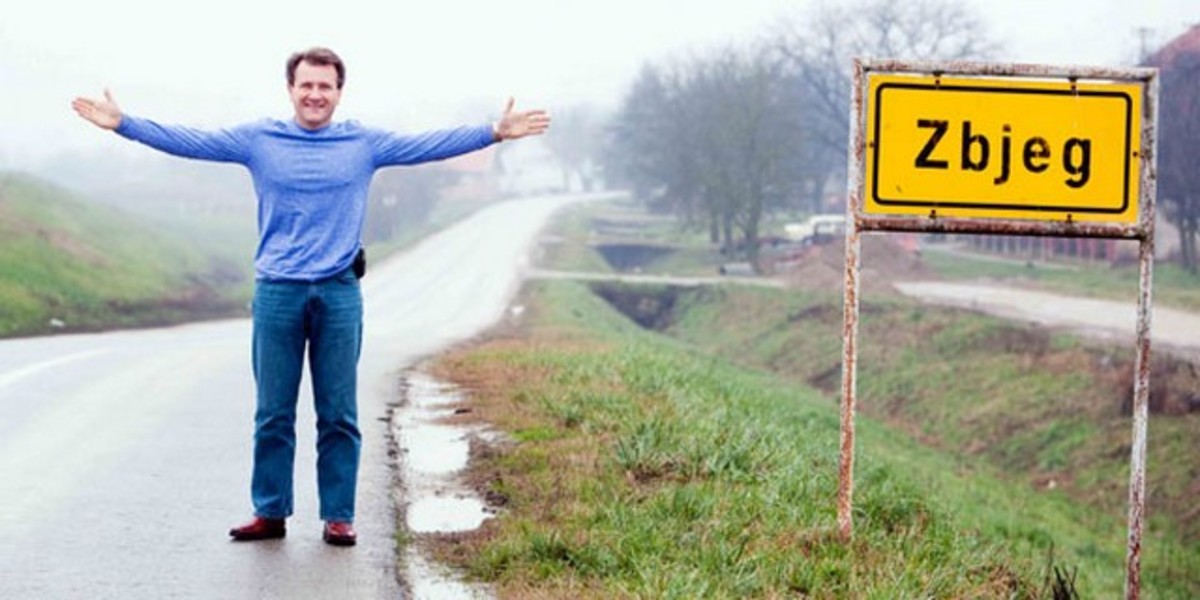Robert Herjavec’s net worth & biggest ‘Shark Tank’ deals

While he’s not the richest of NBC’s startup-funding school of sharks, Robert Herjavec’s notable net worth is all the more impressive when examined in light of his highly humble beginnings.
Best known as one of “Shark Tank’s” loveable but scrupulous venture capitalists, Herjavec’s television career actually began with the Show’s Canadian predecessor and counterpart, “Dragon’s Den,” on which he served as a panelist for the first six seasons.
Well before either of these programs was conceived, Herjavec was born in Yugoslavia in a farming community in 1962. He was only eight years old when his family emigrated to Canada with little in the way of assets or prospects.
Despite growing up far poorer than most of his peers and having to learn English on the fly, Herjavec managed to work his way through school, graduate from college, and eventually make it big in the business world, paving the way for his eventual career as one of television’s best-known small business investors.
💵💰Don’t miss the move: Subscribe to TheStreet’s free daily newsletter💰💵
Here’s what Herjavek is worth in 2025, how his net worth compares to that of his “Shark Tank” co-hosts, and an overview of his most successful investments on the show.
“My motto? Constant, forward momentum.”
—Robert Herjavec

Christopher Willard/Getty Images
What is Robert Herjavec’s net worth in 2025?
Robert Herjavec’s exact net worth is unclear, but most sources agree he is worth at least $300 million, and some estimate his wealth as high as twice that at $600 million. In either case, his wealth qualifies him as a member of the 1% by net worth.
While he’s not a billionaire like his costars Mark Cuban and Daniel Lubetzky, he is a member of the somewhat exclusive nine-figure club, so he’s certainly got the capital necessary to take the occasional gamble on a fledgling business that demonstrates growth potential on “Shark Tank.”
Related: Kevin O’Leary’s net worth as he eyes TikTok purchase
How does Herjavec’s wealth compare to that of the other sharks?
Herjavec is either the third-richest, fourth-richest, or fifth-richest shark on “Shark Tank.”
With a net worth of $300 million, he would be the fifth richest, ahead of Lori Greiner and Barbara Corcoran. With a net worth of $600 million, he would be the third richest behind the show’s two billionaires, Mark Cuban and Daniel Lubetzky.
Here’s how all of the show’s sharks stack up in terms of wealth:
‘Shark Tank’ Sharks by net worth
- Mark Cuban: $5.7–$8.09 billion
- Daniel Lubetzky: $2.7 Billion
- Kevin O’Leary: $400 million
- Daymond John: $350 million
- Robert Herjavec: $300–$600 million
- Lori Greiner: $150 million
- Barbara Corcoran: $100 million
“The harder I work, the luckier I am.”
—Robert Herjavec
Related: Barbara Corcoran’s net worth in 2025: The Shark Tank star’s wealth & investments
Herjavec’s best ‘Shark Tank’ investments
As one of the show’s permanent panelists since its first season, Herjavec has had ample opportunity to get in on the ground floor of the countless fledgling companies that have graced “Shark Tank” set over the course of its 16-season tenure.
That being said, despite his jovial personality, astute viewers have noticed that contestants often go with other sharks’ offers over Herjavec’s when multiple panelists are interested in investing.
Nevertheless, Robert has traded his dollars for equity in quite a few companies on the show, and many of them have gone on to find success in their industries. Here are a few of Herjavec’s best “Shark Tank” investments:
Tipsy Elves (2013)
In a 2013 episode of the “Tank,” Herjavec made his best investment to date, trading $100,000 for a 10% stake in a company called Tipsy Elves. The brand, founded by a pair of former professionals (a dentist and a lawyer), produced purposefully ugly, often inappropriate, and always silly Christmas sweaters for cheeky customers to wear to holiday parties.
None of the other sharks wanted in. Despite the specificity of the product and the stiff competition of the online retail market, Herjavec decided to invest because of the fervor and passion he saw in the founders. He told CNBC, “I didn’t bet on the product, I bet on the guys.”
Herjavec’s hunch paid off, and by 2019, the company had racked up over $100 million in sales. In the years since Rob’s investment, Tipsy Elves has expanded well beyond parody Christmas apparel and now sells a massive range of not-so-serious garments ranging from retro-themed one-piece ski suits to boldly patterned golf polos.
Related: Mark Cuban’s net worth ahead of ‘Shark Tank’ departure
Drain Strain (2015)
In a 2015 episode of the show’s sixth season, entrepreneur Naushad Ali approached the sharks with Drain Strain, a company that had plans to produce a drain plug with a unique attachment that catches hair and other debris to prevent clogging.
Since the company had a patent but no sales, Kevin O’Leary suggested that Ali’s best way forward would be to license the product to a plumbing company that would then market and sell it. O’Leary offered $110,000 for 20% of the company and offered to make a phone call to help secure licensing.
In response, Herjavec remarked that 20% in exchange for a phone call wasn’t fair, offering Ali the same sum but for just 10% equity and a promise to be helpful in the business beyond the licensing process. Ali accepted, and in the intervening years, the company grew. Drain Strain’s products are now available on Amazon as well as the company’s own website, and by 2023, annual revenue reportedly surpassed $2 million.
Sand Cloud (2017)
In a 2017 episode, Herjavec ended up being the lucky shark to swim away with a stake in Sand Cloud, a company that produces Turkish cotton beach towels with pillow inserts and an environmental mission to donate 10% of profits to marine life preservation charities.
Cuban, John, and O’Leary also made offers to Sand Cloud, but Herjavec’s past success with Tipsy Elves ended up winning over the trio of entrepreneurs behind the beach apparel company. When all was said and done Herjavec exchanged $200,000 for 15% ownership in the company.
In the years since the deal was struck, Sand Cloud has grown substantially in terms of both revenue and brand recognition, broadening its product offerings to include sunscreens, umbrellas, backpacks, and home goods.
Sand Cloud continues to use a portion of its profits to support organizations like the Global Penguin Society, and in 2017, founders Steven Ford, Brandon Leibel, and Bruno Aschidamini even won the “Best Raving Fan Culture” award in Tony Robbins’ “Build a Bigger Business” Shopify competition.
Butter Cloth (2018)
In a 2018 episode of “Shark Tank’s” 10th season, Herjavec struck a deal that was close to his heart as an immigrant from humble means, cementing the episode as one to remember for his misty-eyed reaction to the story of Vietnamese entrepreneur Danh Tran.
Tranh, who emigrated to California to follow his dreams of launching a fashion brand, founded Butter Cloth with American partner Gary Falkenberg. The two were joined by former NBA player Metta Sandiford-Artest (FKA Metta World Peace), who served as a spokesperson for the brand, performing a slam dunk on air while wearing one of Butter Cloth’s dress shirts.
And while the soft, sustainable, breathable, and flexible garments Butter Cloth produced appealed to all of the sharks, most dropped out due to the stiff competition the entrepreneurs would face in the fashion industry. Herjavec, touched on a personal level and impressed by the product and the founders, invested $250,000 for a quarter of the company.
In the years since Robert’s emotionally charged cash injection, Butter Cloth has grown, reportedly bringing in revenue of over $5 million annually by 2022 and over $6 million annually by 2024. Herjavec even has his own collection of dress shirts available on the brand’s website.
Robert Herjavec’s early life
Herkjavec was born in 1962 in a part of Yugoslavia that would later become Croatia. His father, Vladimir, was a political dissident who was repeatedly jailed for speaking out against the Yugoslav state and communism in general — particularly when he was in his cups. As a result of his views, Vladimir had trouble maintaining gainful employment and decided to emigrate to Canada with his family in search of a fresh start in 1971.
In Robert’s words, “My dad escaped from jail in a communist country and grabbed my mom and me, and we came to Halifax when I was 8 years old. We landed with literally one suitcase. My mom remembered she knew somebody in Toronto; we took a train there and lived in their basement for 18 months. It all started from there.”

CBC via Croatia.org
Back in Yugoslavia, Herjavec’s family lived on a farm, as did all of their neighbors. It was only once his family relocated to North America that Herjavec realized that, by Canadian standards, he and his family were very poor.
Despite having no experience with the English language — and the numerous disadvantages that came with his family’s immigrant status and lack of financial means — Herjavec made it through school, attended the University of Toronto, and graduated in 1984. Interestingly, he didn’t study business or technology, instead opting for a degree in English and political science.
After graduating, Herjavec spent the next few years working low-paying jobs in retail, dining, and delivery before entering the film and television business in the mid-1980s.
More net worth:
- Tony Robbins’ net worth in 2025 as the world’s top coach
- Scott Galloway’s net worth: The podcaster’s wealth & income in 2025
- Dave Ramsey’s net worth: The retirement expert’s wealth in 2025
How did Herjavec make his money? His career explained
After spending a few of his post-collegiate years drifting between odd jobs, Herjavec spoke with his father, who reportedly told him, “I went through hell so that you could have the opportunity I never had,” providing the push he needed to get serious about a career.
Logiquest
This was when he took his first real step into the technology business. Despite his lack of experience or relevant education, Herjavec landed a sales job at Logiquest by proposing that he work for free for six months to demonstrate his aptitude. He waited tables on the side to keep him afloat during this informal pseudo-internship.
The plan worked, and Herjavec performed well in tech sales, eventually moving up within the company into managerial roles. In 1990, however, he was fired, leading him to the decision to start his own business for the first time.
Related: Joe Rogan’s net worth: The controversial podcaster’s income & investments
BRAK Systems
The result was BRAK Systems, a company that integrated internet security software. Herjavec grew the business quickly, eventually selling it to AT&T Canada for $30.2 million less than 10 years after he founded it. He next took on an executive sales role at Ramp Network, another tech company, but this didn’t last long. He helped negotiate the company’s sale to Nokia for a whopping $225 million before retiring at the young age of 40.
Herjavec enjoyed his retirement for a few years, spending time at home with his children, but once they went back to school three years later, he got a case of cabin fever and jumped back into the business world, founding the Herjavec Group. “I was just too young to stay retired, he said.”
The Herjavec Group
In 2003, Herjavec and two partners founded the Herjavec Group, a cybersecurity and internet technology firm. During its first year in business, the company posted $400,000 in sales, which was a solid start despite falling short of the founders’ projections.
Herjavec and Co. built on this foundation in the years that followed, growing the company’s revenue and assets through occasional acquisitions and gradual expansions into new markets. Eventually, the company built data centers in Canada, the U.S. and the U.K. and expanded its services to include consulting and compliance solutions for payment cards.
By 2009, the Herjavec Group posted $35.6 million in revenues. By 2017, this number reached $200 million. In 2021, Herjavec sold a majority stake in the company he had built to private equity firm Apex Partners, but he retained some ownership in the company and stayed on as CEO until 2024 when he stepped down, saying “I’m excited to spend more time with my passions—investing [and] mentoring entrepreneurs through ‘Shark Tank’—and most importantly, with my family.”
Related: Suze Orman’s net worth in 2025: The personal finance icon’s wealth
Who is Robert Herjavec’s wife?
Not all of Herjavec’s reality TV roles have been business-related.
His “Dragon’s Den” and subsequent “Shark Tank” notoriety cemented him as a certified celebrity, and he was selected to be a contestant on the 15th season of “Dancing With the Stars,” a reality competition in which celebrity contestants are paired with professional dancers and perform various dance styles together over the course of the season.
And while Hejavec and his professional dance partner, Kym Johnson, didn’t take home the show’s Len Goodman Mirrorball Trophy, they did score an equally valuable prize — each other.
The competition partners confirmed to People Magazine in 2015 that they were an item. They were engaged in February 2016 and married in a summer ceremony just months later. By the end of 2017, the pair announced that they were expecting, and in spring of 2018, Kym gave birth to twins Hudson Robert Herjavec and Haven Mae Herjavec.
Robert also has three children from his first marriage to Diane Plese, whose parents, like Herjavec’s, immigrated to Canada from Yugoslavia. The pair married in 1990 but separated in 2014 and divorced in 2016.
Related: Veteran fund manager unveils eye-popping S&P 500 forecast
#Robert #Herjavecs #net #worth #amp #biggest #Shark #Tank #deals




